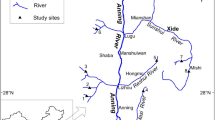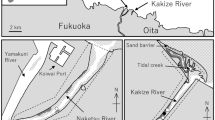Abstract
The gammaridean amphipods Cymadusa compta (Smith), Gammarus mucronatus Say, Melita nitida Smith and Grandidierella bonnieroides Stephensen from a seagrass community in the Indian River estuary of Florida (USA) fed variously upon large drift algae, small algae epiphytic on seagrasses and seagrass leaf debris and detritus. Consumption was measured in the laboratory using an index (CI) equivalent to mg ingested mg-1 amphipod day-1. Observations revealed that the amphipods fed by macrophagy, an attack upon large algae and seagrass debris, and by microphagy, small particle detritus feeding and scraping of plant surfaces for diatoms and other epiphytic algae. C. compta was a macrophagous feeder with a generalized diet of algae and seagrass debris, preferring epiphytic algae and drift algae at mean rates of 1.10 and 0.87 CI, respectively. Gammarus mucronatus fed upon epiphytes and seagrass debris equally at mean rates of 0.90 and 0.97 CI, respectively. The diet of M. nitida condisted primarily of epiphytes, consumed at an average rate of 1.05 CI. Grandidierella bonnieroides fed in a specialized microphagous manner, “grooming” plant surfaces for small particle detritus and diatoms at an approximate CI rate of 1.45. Assimilation of plants ingested, as reflected by carbon-14 uptake, varied similarly among the 4 amphipods. Epiphytic algae appeared to be most useful as food, providing means of 41 to 75% carbon-14 uptake as ingesta. Drift algae and seagrass debris were of less value, with means varying between 11 and 24 % of carbon-14 uptake by the amphipods. The data show a pattern of feeding which resembles resource partitioning of food both by size and kind. Other evidence, however, including population limitation by predators and an apparent overabundance of food, indicate that resource partitioning as seen may be an artifact, and one which has no co-evolutionary basis among the present species.
Similar content being viewed by others
Literature Cited
Barnard, J.L.: The families and genera of marine gammaridean Amphipoda. Bull. U.S. natn. Mus. 271, 1–535 (1969)
Brook, I.M.: Trophic relationships in a seagrass community (Thalassia testudinum) in Card Sound, Florida. Fish diets in relation to macrobenthic and cryptic faunal abundance. Trans. Am. Fish. Soc. 106, 219–229 (1977)
Brenner, D., I. Valiela and C.D. Van Raalte: Grazing by Talorchestia longicornis on an algal mat in a New England salt marsh. J. exp. mar. Biol. Ecol. 22, 161–169 (1976)
Cummins, K.W., R.C. Petersen, F.O. Howard, J.C. Wuycheck and V.I. Holt: The utilization of leaf litter by stream detritivores. Ecology 54, 336–345 (1973)
Darnell, R.M.: Organic detritus in relation to the estuarine ecosystem. In: Estuaries, pp 376–382. Ed. by G.H. Lauff. Washington, D.C.: American Association for the Advancement of Science 1967. (Publs Am. Ass. Advmt Sci. No. 83).
Eiseman, N.J. and M.C. Benz: Studies of the benthic plants of the Indian River Region. In: Indian River coastal zone study, 2nd annual report, Vol. 1. pp 89–103. Ed by D.K. Young. Fort Pierce, Florida: Harbor Branch Foundation, Inc. 1975
Fenchel, T.: Studies on the decomposition of organic detritus derived from the turtle grass Thalassia testudinum. Limnol. Oceanogr. 15, 14–20 (1970)
Greze, I.I.: Feeding habits and food requirements of some amphipods in the Black Sea. Mar. Biol. 1, 316–321 (1968)
Halcrow, K.: Cellulase activity in Gammarus oceanicus Seagerstrale (Amphipoda). Crustaceana 20, 121–124 (1971)
Hargrave, B.T.: the utilization of benthic microflora by Hyalella azteca (Amphipoda). J. Anim. Ecol. 9, 427–437 (1970)
Harrison, P.G.: Decomposition of macrophyte detritus in seawater: effects of grazing by amphipods. Oikos 28, 165–169 (1977)
Heald, E.J.: The production of organic detritus in a South Florida estuary, 110 pp. Dissertation, University of Miami, Coral Gables, Florida 1969
Keith, D.E.: Aspects of feeding in Caprella californica Stimpson and Caprella equilibra Say (Amphipoda). Crustaceana 16, 119–124 (1969)
Ledoyer, M.: Amphipods gammariens des herbiers de phanerogames marines de la région de Tuléar (République Malagache) étude systématique et écologique. Annls Fac. Sci. Univ. Madagascar 5, 121–170 (1967)
Lynch, M.: Zooplankton competition and plankton community structure. Limnol. Oceanogr. 22, 775–777 (1977)
Monk, D.C.: The digestion of cellulose and other dietary components and pH of the gut in the amphipod Gammarus pulex (L.) Freshwat. Biol. 7, 431–440 (1977)
Nagle, S.J.: Distribution of the epibiota of macroepibenthic plants. Contr. mar. Sci. Univ. Tex. 13, 105–144 (1968)
Nelson, W.G.: The population dynamics of eelgrass (Zostera marina) amphipods. Presentation at the 39th meeting of Limnology and Oceanography at Skidaway Laboratory, Savannah, Ga. 1976. (Unpublished manuscript; copies available from: Dr. W.G. Nelson, Harbor Branch Foundation, Fort Pierce, Fla. 33450, USA)
Nilsson, L.M.: Energy budget of a laboratory population of Gammarus pulex (Amphipoda). Oikos 25, 35–42 (1974)
Stephens, F.C. and R.A. Gibson: Studies of epiphytic diatoms in the Indian River, Florida. In: Indian River coastal zone study, 3rd annual report, Vol. 1. pp 61–70. Ed. by D.K. Young. Fort Pierce, florida: Harbor Branch Foundation, Inc. 1976
Waldbauer, G.P.: The consumption and utilization of food by insects. Adv. Insect Physiol. 5, 229–282 (1968)
Wildish, D.J. and N.J. Poole: Cellulase activity in Orchestia gammarella (Pallas). Comp. Biochem. Physiol. 33, 713–716 (1970)
Young, D.K., M.A. Buzas and M.V. Young: Species densities of macrobenthos associated with seagrass: a field experimental study of predation. J. mar. Res. 34, 577–592 (1976)
— and M.W. Young: Community structure of the macrobenthos associated with seagrass of the Indian River estuary, Florida. In: Ecology of marine benthos, pp 359–381. Ed. by B.C. Coull. Columbia: University of South Carolina Press 1977
Zieman, J.C., Jr.: A study of the growth and decomposition of the seagrass Thalassia testudinum, 50 pp. M.S. thesis, University of Miami, Coral Gables Florida 1968
Zimmerman, R.J.: Detritivorous amphipods from Thalassia beds near La Parguera, Puerto Rico. Proceedings of the Association of Island Marine Laboratories of the Caribbean (Abstract) 1, p. 16. Mayaguez: Department of Marine Sciences, University of Puerto Rico 1976
Author information
Authors and Affiliations
Additional information
Communicated by M.R. Tripp, Newark
Contribution No. 102 of Harbor Branch Foundation, Inc.
Rights and permissions
About this article
Cite this article
Zimmerman, R., Gibson, R. & Harrington, J. Herbivory and detritivory among gammaridean amphipods from a Florida seagrass community. Mar. Biol. 54, 41–47 (1979). https://doi.org/10.1007/BF00387050
Accepted:
Issue Date:
DOI: https://doi.org/10.1007/BF00387050




